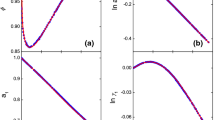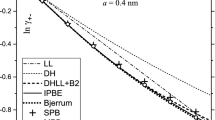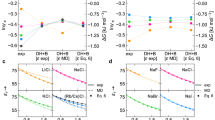Abstract
Contrary to widely held beliefs, many concentrated aqueous solutions of strong electrolytes and nonelectrolytes are shown to behave ideally by calculating the activity of water (a w) from vapor pressure data. The mole fraction of water (x w) is equal to the water activity a w(Raoult’s Law) when the mole fraction of water is calculated by accounting for water strongly bound to the solute, which is then not available to act as solvent. In this case x w=(55.51−mH T)/(55.51−mH T+im), where m is the molality of the solute particles, i is the stoichiometric number of solute particles produced per mole of dissolved solute, and H T is the thermodynamic hydration number H T. Published reservations about previous work of this type are addressed. The values of H T vary little over wide ranges of concentration and correlate with the Hofmeister series, the B coefficient of the Jones-Dole viscosity equation, and other properties of water. Activity coefficients of the bulk or “free” water remain at unity even at high concentrations.
Similar content being viewed by others
References
Blandamer, M.J., Engberts, J.B.F.N., Gleeson, P.T., Reis, J.C.R.: Activity of water in aqueous systems; a frequently neglected property. Chem. Soc. Rev. 34, 440–458 (2005)
Zavitsas, A.A.: Properties of water solutions of electrolytes and nonelectrolytes. J. Phys. Chem. B 105, 7805–7817 (2001)
Bockris, J.O.M., Reddy, A.: Modern Electrochemistry, 2nd edn., p. 293 and ff. Plenum Press, New York (1998)
Lewis, G.N.: The activity of the ions and the degree of dissociation of strong electrolytes. J. Am. Chem. Soc. 34, 1631–1644 (1912)
Scatchard, G., Hamer, W.J., Wood, S.E.: Isotonic solutions I. The chemical potential of water in aqueous solutions of sodium chloride, potassium chloride, sulfuric acid, sucrose, urea and glycerol at 25 °C. J. Am. Chem. Soc. 60, 3061–3070 (1938)
Stokes, R.H., Robinson, R.A.: Interactions of aqueous nonelectrolyte solutions I. Solute–solvent equilibria. J. Phys. Chem. 70, 2126–2131 (1966)
Washburn, E.W. (ed.): International Critical Tables of Numeric Data, Physics, Chemistry and Technology, vol. 3, pp. 292–300, 351–373. McGraw-Hill, New York (1928)
Levine, I.N.: Physical Chemistry, 6th edn., p. 313. McGraw-Hill, New York (2009)
Glasstone, S.: The Elements of Physical Chemistry, p. 418. D. Van Nostrand, Princeton (1946)
Einstein, A.: Eine neue Bestimmung der Molecül-dimensionen. Ann. Physik. 19, 289–301 (1906)
Einstein, A.: Berichtigung zu meiner Arbeit: “Eine neue Bestimmung der Molecül-dimensionen. Ann. Physik. 34, 591–592 (1911)
Berkeley, Earl of, Hartley, E.G.J.: Further determinations of direct osmotic pressures. Proc. R. Soc. Lond. A 92, 477–492 (1916)
Berkeley, Earl of, Hartley, E.G.J., Burton, C.V.: On osmotic pressures derived from vapour-pressure measurements: aqueous solutions of cane sugar and methyl glucoside. Phil. Trans. R. Soc. Lond. A 218, 295–349 (1919)
Scatchard, G.: The hydration of sucrose in water solution as calculated from vapor-pressure measurements. J. Am. Chem. Soc. 43, 2406–2418 (1921)
Stokes, R.H., Robinson, R.A.: Ionic hydration and activity in electrolyte solutions. J. Am. Chem. Soc. 70, 1948 (1870–1878)
Ohtaki, H., Radnai, T.: Structure and dynamics of hydrated ions. Chem. Rev. 93, 1157–1204 (1993)
Arshadi, M., Yamdagni, R., Kebarle, P.: Hydration of the halide negative ions in the gas phase II. Comparison of hydration energies for the alkali positive and halide negative ions. J. Phys. Chem. 74, 1475–1482 (1970)
Xantheas, S.S.: Quantitative description of hydrogen bonding in chloride–water clusters. J. Phys. Chem. 100, 9703–9713 (1996)
Ayala, R., Martínez, J.M., Pappalardo, R.R., Sánchez, Marcos: E.: Theoretical study of the microsolvation of the bromide ion in water, methanol, and acetonitrile: ion–solvent vs solvent–solvent interactions. J. Phys. Chem. A 104, 2799–2807 (2000)
Impey, R.W., Madden, P.A., McDonald, I.R.: Hydration and mobility of ions in solution. J. Phys. Chem. 87, 5071–5083 (1983)
Du, H., Rasaiah, J.C., Miller, J.D.: Structural and dynamic properties of concentrated alkali halide solutions: a molecular dynamics simulation study. J. Phys. Chem. B 111, 209–217 (2007)
Tongraad, A., Rode, B.M.: The hydration structures of F− and Cl− investigated by ab initio QM/MM molecular dynamics simulations. Phys. Chem. Chem. Phys. 5, 357–362 (2003)
Buchner, R., Hefter, G.T., May, P.M.: Dielectric relaxation of aqueous NaCl solutions. J. Phys. Chem. A 103, 1–9 (1999)
Zavitsas, A.A.: Aqueous solutions of calcium ions: hydration numbers and the effect of temperature. J. Phys. Chem. B 109, 20636–20640 (2005)
Lindqvist-Reis, P., Klenze, R., Schubert, G., Fanghänel, T.: Hydration of Cm3+ in aqueous solution from 20 to 200 °C. A time-resolved laser fluorescence spectroscopy study. J. Phys. Chem. B 109, 3077–3083 (2005)
Mason, C.M.: The activity and osmotic coefficients of trivalent metal chlorides in aqueous solution from vapor pressure measurements at 25 °C. J. Am. Chem. Soc. 60, 1638–1647 (1938)
Hamer, W.J., Wu, Y.-C.: Osmotic coefficients and mean activity coefficients of uni-univalent electrolytes in water at 25 °C. J. Phys. Chem. Ref. Data 1, 1047–1099 (1972)
Goldberg, R.N., Nuttall, R.L.: Evaluated activity and osmotic coefficients for aqueous solutions: the alkaline earth metal halides. J. Phys. Chem. Ref. Data 7, 263–310 (1978)
Robinson, R.A., Stokes, R.H.: Activity coefficients in aqueous solutions of sucrose, mannitol and their mixtures at 25 °C. J. Phys. Chem. 65, 1954–1958 (1961). The osmotic coefficients of the sucrose solutions are obtained as specified therein: φ=1+0.07028m+0.01847m 2−0.00405m 3+0.000228m 4;φ is converted to p/p 0 as described in the Introduction
Hofmeister, F.: Zur Lehre von der Wirkung der Salze. Arch. Exp. Pathol. Pharmakol. (Leipzig) 24, 247–260 (1888)
Lonetti, B., Lo Nostro, P., Ninham, B., Baglioni, P.: Anion effects on calixarene monolayers: a Hofmeister series study. Langmuir 21, 2242–2249 (2005)
Kunz, W., Lo Nostro, P., Ninham, B.W.: The present state of affairs with Hofmeister effects. Curr. Opin. Colloid Interface Sci. 9, 1–18 (2004)
Bowron, D.T., Finney, J.L.: Structure of a salt–amphiphile–water solution and the mechanism of salting out. J. Chem. Phys. 118, 8357–8372 (2003)
Finney, J.L., Bowron, D.T.: Experimental configurational landscapes in aqueous solutions. Phil. Trans. R. Soc. A 363, 469–492 (2005)
Broering, J.M., Bommarius, A.S.: Evaluation of Hofmeister effects on the kinetic stability of proteins. J. Phys. Chem. B 109, 20612–20619 (2005)
Chaplin, M.: Provides a good description of Hofmeister effects at http://www.lsbu.ac.uk/water/hofmeist.html (2009)
Lo Nostro, P., Ninham, B.W., Lo Nostro, A., Pesavento, G., Fratoni, L., Baglioni, P.: Specific ion effects on the growth rates of Staphylococcus aureus and Pseudomonas aeruginosa. Phys. Biol. 2, 1–7 (2005)
Sedlák, E., Stagg, L., Wittung-Stafshede, P.: Role of cations in stability of acidic protein Desulfovibrio desulfuricans apoflavotoxin. Arch. Biochem. Biophys. 474, 128–135 (2008)
Trachman, J.D., Yasmin, M.: Thermo-osmoregulation of heat-labile enderotoxin expression by Escherichia coli. Curr. Microbiol. 49, 353–360 (2004)
Kiriukin, M.Y., Collins, K.D.: Dynamic hydration numbers for biologically important ions. Biophys. Chem. 99, 155–168 (2002)
De Cristofaro, R., Peyvandi, F., Palla, R., Lavoretano, S., Lombardi, R., Merati, G., Romitelli, F., Di Stasio, E., Mannuccio Mannucci, P.: Role of chloride ions in modulation of the interaction between von Willebrand factor and ADAMTS-13. J. Biol. Chem. 280, 23295–23302 (2005)
Munishkina, L.A., Henriques, J., Uversky, V.N., Fink, A.L.: Role of protein–water interactions and electrostatics in α-Synuclein fibril formation. Biochem. 43, 3289–3300 (2004)
Corey, H.E.: Stewart and beyond: New models of acid-base balance. Kidney Int. 64, 777–787 (2003)
Grover, P.K., Ryall, R.L.: Critical appraisal of salting-out and its implications for chemical and biological sciences. Chem. Rev. 105, 1–10 (2005)
Zangi, R., Engberts, J.F.N.: Physisorption of hydroxide ions from aqueous solution to a hydrophobic substance. J. Am. Chem. Soc. 127, 2272–2276 (2005)
Vácha, R., Zangi, R., Engberts, J.B.F.N., Jungwirth, P.: Water structuring and hydroxide ion binding at the interface between water and hydrophobic walls of varying rigidity and van der Waals interactions. J. Phys. Chem. B 112, 7689–7692 (2008)
Zangi, R., Hagen, M., Berne, B.J.: Effect of ions on the hydrophobic interaction between two plates. J. Am. Chem. Soc. 129, 4678–4686 (2007)
Zangi, R., Berne, B.J.: Aggregation and dispersion of small hydrophobic particles in aqueous electrolyte solutions. J. Phys. Chem. B 110, 22736–22741 (2006)
Jenkins, H.B., Marcus, Y.: Viscosity B-coefficients of ions in solution. Chem. Rev. 95, 2695–2724 (1995)
Marcus, Y.: Effect of ions on the structure of water: structure making and breaking. Chem. Rev. 109, 1346–1370 (2009)
Azam, S.S., Hofer, T.S., Bahttacharjee, A., Lim, L.H.V., Pribil, A.B., Randolf, B.R., Rode, B.M.: Beryllium(II): the strongest structure-forming ion in water? A QMCF MD simulation study. J. Phys. Chem. B 113, 9289–9295 (2009)
Omta, A.W., Kropman, M.F., Woutersen, S., Bakker, H.J.: Influence of ions on the hydrogen-bond structure in liquid water. J. Chem. Phys. 119, 12457–12461 (2003)
Näslund, L.-Ǻ., Edwards, D.C., Wernet, P., Bergmann, U., Ogasawara, H., Pettersson, L.G.M., Myneni, S., Nilsson, A.: X-ray absorption spectroscopy study of the hydrogen bond network in the bulk water of aqueous solutions. J. Phys. Chem. A 109, 5995–6002 (2005)
Smith, J.D., Saykally, R.J., Geissler, P.L.: The effects of dissolved halide ions on hydrogen bonding in liquid water. J. Am. Chem. Soc. 129, 13847–13856 (2007)
Author information
Authors and Affiliations
Corresponding author
Electronic Supplementary Material
Below is the link to the electronic supplementary material.
Rights and permissions
About this article
Cite this article
Zavitsas, A.A. Ideal Behavior of Water Solutions of Strong Electrolytes and Non-electrolytes at High Concentrations. J Solution Chem 39, 301–317 (2010). https://doi.org/10.1007/s10953-010-9503-3
Received:
Accepted:
Published:
Issue Date:
DOI: https://doi.org/10.1007/s10953-010-9503-3




